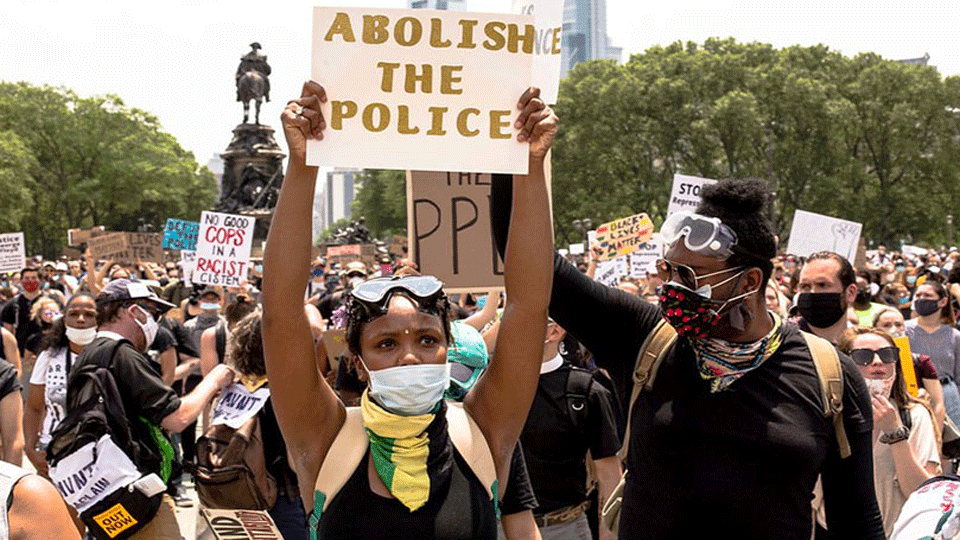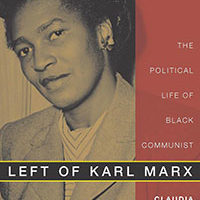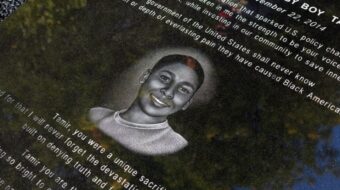
Since the Trayvon Martin murder in 2012 and the Ferguson uprising in 2014, the Movement for Black Lives has further developed its demands from so-called ‘reformist’ reforms such as new police training methods, “community policing,” body cameras, and diversity in hiring to a more militant stance of defunding and eventually abolishing the police in the aftermath of the most recent violent police murder of George Floyd in Minnesota.
How did we get here? Anti-Black racism and settler colonialism are built into the very foundation of our society, giving rise to a white supremacist superstructure. This means that the struggles against racism and capitalism are separate but intertwined, parallel (but not identical) fights that together move toward a just future. The revolutionary V.I. Lenin saw the struggle for democracy indivisibly bound up with the struggle against racism and class and national oppression. He said the fight for democracy was key to advancing unity among the workers of the oppressor nation and the people of any oppressed nation or nationality.1
Henry Winston, a former chair of the Communist Party USA, said that from its inception, his organization saw the struggle against racist oppression as part of the class struggle and recognized that Black people were oppressed as a people. “Labor with a white skin and labor with a Black skin,” Winston said in his book Strategy for a Black Agenda, “could not be free unless the special demands of the triply-oppressed Black people were put at the center of the struggle for progress and socialism.”2

Following the end of chattel slavery and the expansion of industrial capitalism to the U.S. South, new ways of sustaining the essence of slavery emerged in order to keep profits in the hands of the ruling class. Such means included the penal and convict lease systems and the modern prison-industrial complex, which now contains the largest prison population in the world and holds one-third of Black men (and increasingly Black women, trans, and gender-nonconforming folks) under its control.
In Are Prisons Obsolete?, Angela Davis explains that, with the U.S. and global capitalist economy driven by pursuit of profit and, in recent decades, the dismantling of the welfare state, “poor people’s abilities to survive became increasingly constrained by the looming presence of the prison.” Elected officials and the corporate media justified new sentencing practices (for example, the 1994 Crime Bill)—thus sending more and more people to prison in and embarking on a frenzied drive to build more and more prisons—“by arguing that this was the only way to make our communities safe from murderers, rapists, and robbers.”3
Mass incarceration of Black and brown people expanded due to new national crime policies, such as the War on Drugs, neoliberal cuts in funding of the social safety net, poverty and housing policies leading to chronic homelessness, draconian immigration measures, and expanding policing in schools while cutting public education budgets. This led to the now widely known “school-to-prison” pipeline, where Black youth are heavily criminalized not only in their own neighborhoods and communities but also in their spaces of learning. Alex Vitale in End of Policing writes:
“In 1994 [Bill Clinton] introduced the Gun-Free Schools Act, which ushered in ‘zero tolerance’ school discipline policies. Following that lead, legislators and school administrators embraced a raft of harsh disciplinary codes, placing surveillance systems, metal detectors, and huge numbers of police in schools. These policies have led to the growing criminalization of young people, despite falling crime rates. According to the Department of Education, 92,000 arrests were made in the 2011–2012 school year…. Schools with high percentages of students of color are more likely to have zero tolerance policies and generate more suspensions, expulsions, and arrests.”4
Mass incarceration has reverberating effects that put more profits into the hands of the ruling class. For example, states like Florida and others take former inmates’ citizenship away by removing their right to register to vote if they have a felony on their record. (Florida’s voters recently approved a ballot measure to restore voting rights; this has been overturned and replaced by a modern-day poll tax fiasco.) On top of this, felony convictions on a person’s record lead to more difficulty in finding employment for these “returning citizens.”
Private profit has also been a result of the heavy reliance on criminal punishment and imprisonment, leading to the construction of private prisons and detention centers, where many of these prisons have inmates performing slave labor for private companies like department store J.C. Penney. Also, state and federal penitentiaries have inmates perform prison labor—an example being the prisoners fighting fires in California or the products sold by companies such as Bounty paper towels, Crest toothpaste, Emergen-C, hand sanitizer, and many more sold by corporations. And we cannot leave out the global context, with private contractors like G4S who profit off increased security at U.S. schools, surveillance at the U.S.-Mexico border, and Israeli apartheid measures on Palestinians.5
Abolition and “reforms vs. reforms”
Abolition has to be understood as a process and a call to action, not some empty ultra-revolutionary rhetoric. Further, to call oneself an abolitionist is to want to abolish the conditions that subject majorities of Black people. We (Black people) cannot wait for socialist revolution or global communism to put an end to the conditions of criminalization, mass incarceration, and state violence—and ending those is what this current uprising against police terror is about.
In fact, Marxism insists that socialism will never be achieved unless the demands of Black people and other people of color be addressed in the here and now. Understanding the basic Marxist-Leninist analysis of the state as a repressive tool of the ruling class and a site of democratic struggle does not mean the independent character of the Black liberation struggle can be ignored, as Winston warned. Because capitalism is built on racism, anti-racist struggles are fundamental to its undoing.
“Abolition means not just the closing of prisons [and subsequently, the dismantling of the police] but the presence, instead, of vital systems of support that many communities lack,” prison scholar and geographer Ruth Wilson Gilmore argued in the New York Times recently. Since the term “prison-industrial complex” was coined by Mike Davis in the 1990s and Angela Davis popularized the phrase “prison abolition” through her speaking and writing, these ideas have picked up a lot of steam in the past several years. They are increasingly adopted by Black women and Black queer organizers, especially those in Critical Resistance and BYP100 who have understood the role of racist and gender violence as a form of super-exploitation in the modern prison-industrial complex.
The question we need to be challenging ourselves with is: How do we actually create new forms of public safety, and how do we not reproduce forms of harm and violence?
Calls to “reform” the police are often just another way justify giving the police more funding, expanding their budgets, and legitimizing their function in society. Campaign Zero, led by DeRay Mckesson, has recently put out a set of reforms aimed at lowering police deaths by 72%, called #8CantWait. These eight reforms include demands of banning chokeholds and strangleholds, requiring de-escalation practices, requiring warning before shooting, exhausting all alternatives before shooting, observing the duty to intervene, banning shooting at moving vehicles, and more.
While these demands seem well-intentioned on the surface, they actually legitimize the function of policing itself in society and are insufficient to bring about real change. In fact, many of these reforms have already been implemented across departments in the United States, including the one which was involved in the killing of George Floyd. Mckesson has also been criticized for being dishonest and watering down the Black Lives Matter movement by using corporate strategies to approach problems such as police violence.
Just to be clear, when we say “reforms” in this article, we are trying to differentiate between so-called “reformist reforms” which give more legitimacy to policing and prisons and expand the reach of these forces—like replacing an old dysfunctional jail with a new modern jail (Hint: it is still a jail) or more training for police officers—and “non-reformist” reforms which move toward dismantling prisons and police as a whole by developing actual tangible alternatives to these structures of violence. Such measures would decrease their footprint—like divesting resources from them and putting those resources into healthcare, housing, and the well-being of communities.
As a response to the #8cantwait campaign led by Mckesson, abolitionist organizers and theorists have created #8ToAbolition, which includes the following:
-
1.) Defund police.
-
2.) Demilitarize communities.
-
3.) Remove police from schools.
-
4.) Free people from jails and prisons.
-
5.) Repeal laws that criminalize survival.
-
6.) Invest in community self-governance.
-
7.) Provide safe housing for everyone.
-
8.) Invest in care, not cops.
Central to these abolitionist reforms is the need to address wage theft and the wage gap by providing resources toward a living wage and special compensatory measures to address past racial and class exploitation, ending unemployment by enacting a jobs guarantee, universal single-payer health care, universal free public education, affordable and accessible housing (through expansion of rent control, public housing, and community land trusts), expansion of democratic enterprises, youth programs (that don’t involve police), etc. #8ToAbolition aims to “build a world where there are zero police murders, because there are zero police, not because police are better trained or better regulated in continuing to uphold systems designed to oppress our communities.”
The end of policing?
Policing has to be understood as a tool of social control in terms of protecting private property (i.e., capitalism) and white supremacy, with its origins in Southern slave patrols and in practices used to suppress workers’ movements in places formerly and currently under colonial and imperialist rule, including workers in the United States. Also, the police and prison-industrial complex are inextricably tied to the military-industrial complex. In addition to receiving free surplus military equipment from the Pentagon through the military’s “1033 program,” police departments are purchasing military equipment directly from private military contractors using grant money from the Department of Homeland Security. Increasingly, the police function as a military occupation force of Black and brown communities.
Further, “stop and frisk” practices which were widely used in New York City (and subsequently replicated in other major cities such as Washington, D.C.) target and harass poor and working-class Black and Latinx youth and put them through the juvenile punishment system. Black trans and queer people are openly targeted by the police as well, an example being the recent police murder of Tony McDade, a Black trans man. The role of the police is to create more harm and violence in society rather than provide public safety.
The possibility of ending the social control function played by police is generating a lot of discussion. The End of Policing, authored by criminal justice scholar Alex Vitale, has gained a lot of traction in the past few weeks during the demonstrations, garnering the author many interviews with Democracy Now!, NPR, and others. Vitale’s book details the flaws of reformist policing and brings to light alternatives to policing and new forms of public safety for communities, including many of those demanded by the #8ToAbolition movement.
Well-known abolitionist organizer Mariame Kaba, founder of Project NIA, a grassroots organization with a vision to end youth incarceration, says:
“We have to create the conditions that decrease the demand for police and surveillance. You need jobs, healthcare, housing, and people need to be able to live their lives. You need to create structures to address harm and hold people accountable. People think abolitionists minimize harm but we take it very seriously. Safety is a collective action.”
Kaba was also a co-founder of We Charge Genocide, an inter-generational effort which documented police violence in Chicago and sent youth organizers to Geneva, Switzerland, to present reports to the United Nations, echoing work done by William L. Patterson, Paul Robeson, and W.E.B. Du Bois in the 1950s as part of the Civil Rights Congress.
In another recent piece in the New York Times, she expanded on the problem that abolitionists face in communicating their proposals, stating that “as a society, we have been so indoctrinated with the idea that we solve problems by policing and caging people that many cannot imagine anything other than prisons and the police as solutions to violence and harm.”
Community control
The recently re-founded National Alliance Against Racist and Political Repression (NAARPR) has also presented steps toward abolition. While the organization emphasizes community control of police through a democratically-elected police accountability board, it has also put more emphasis lately on community control of the city budget in order to cut police expenditures. For example, the movement demanding a Civilian Police Accountability Council (CPAC) in Chicago, headed by Frank Chapman, a NAARPR leader, demands complete control of the local police forces as a step toward Black liberation.
The body it is organizing to win—CPAC—would different from the common Civilian Police Review Boards that exist in many cities but which are too often filled with appointees who are white supremacists and/or allies of the police. Says Chapman:
“Cities are spending large shares of their budgets on police at the expense of social services, health care, infrastructure, and other needs. Democratic community control of the police transforms the power dynamic between police and citizens. Black communities policing the police in their neighborhoods to confront the long-term racist roots of policing in the United States.”
Demands like community control of the police and their budgets give CPAC and similar formations space to struggle and respond to calls to “defund the police.” Expecting bourgeois politicians to respond to these calls will not result in meaningful action. Community control of the police would open up new democratic struggles and put more power in the hands of the community, which could then open up the possibility of dismantling the police through a democratic process. Cities currently seeing organizing around demands inspired by CPAC span from Milwaukee to Salt Lake City to Tallahassee.
Under the CPAC model, “community control” means the following:
– A directly-elected all-civilian council.
– Final authority over police policy, oversight policy, and budget, including writing and reviewing.
– Full authority on disciplinary measures and legal recourse, including subpoena power and the convening of grand juries.
– Hiring and firing power over the police chief or superintendent, all officers on the force, the head of any existing oversight or review boards and offices, and the members of those.
– Full access to all investigations by the oversight or review institutions.
– Broaden the scope of investigations to include all allegations of misconduct, including sexual assault.
– Negotiation on police union contracts.
– Exclude all current and former law enforcement agents from serving on the board.
Critical Resistance, an organization Angela Davis helped found in the late 1990s, has recently critiqued the call for community control. Organizer Kamau Walton says that “community control of the police” sounds like “community control of the military,” since the police (and the military)—an oppressive tool of criminalization and dehumanization—upholds the people in power who are profiting off exploitation. The police in general do not protect Black people, immigrants, gender-nonconforming folks, or workers.
Critical Resistance says that “community control” will not reduce funding of the police, will not challenge the notion that police increase safety, will not reduce the tools, tactics, and technology that police have at their disposal; and will not reduce the scale of policing. Critical Resistance recommends the following: prioritize spending on community health, education, and affordable housing, cap overtime accrual and overtime pay for military exercises and withdraw participation in police militarization programs, require cops to be liable for misconduct settlements, suspend the use of paid administrative leave for cops under investigation, withhold pensions and don’t rehire cops involved in excessive force, and reduce the size of the police force.
It is important to note the historical context as well. The Black Panther Party (BPP) for Self-Defense called for “community control of the police” during their existence and also called for residency requirements for police in the communities they policed (now commonly known as “community policing”). The BPP formed and operated at a time before the term “prison-industrial complex” was coined, and the party was dismantled by COINTELPRO and the FBI before evolving in an abolitionist direction. Critical Resistance aims to build off this historical work rather than repeat it, and to examine the next stage toward liberation by advancing these struggles by the BPP and Black Liberation Army.
We also cannot forget what has happened to the labor movement in the U.S. as a result of the expansion of policing and surveillance. Some historical moments come to mind, such as the Palmer Raids of the first Red Scare after World War I and the McCarthyite war on the working class through the anti-Communist Smith Act and Taft-Hartley bills that targeted known (and unknown) Communists and those who were friendly in the CIO labor unions and Black liberation organizations such as the Sojourners for Truth & Justice and the Southern Negro Youth Congress.
The police and the FBI go hand-in-hand when it comes to disrupting mass people’s movements that desire an alternative to capitalism and racism. These instances set the labor movement back for perhaps decades by jailing leaders of organizations and unions and led to stronger corporate control of the economy while labor was weakened.
Same struggle, same fight
Organizers from the different campaigns of “defund,” “abolish,” and “community control” all see themselves as part of the same struggle toward abolition, even if they have different strategic outlooks on how to get there. For example, Frank Chapman of NAARPR says that CPAC is not at odds with organizers who are pushing for defunding of police budgets or immediate abolition. “The question is how we get to that goal,” says Chapman, who also quotes Charlene Mitchell, a past leader of the CPUSA and NAARPR in the 1970s, advising, “Lead people out of their frustrations, not into them.”
Organizers in these movements, whether new to abolition and revolutionary politics or seasoned veterans, have to understand how closely linked our neoliberal capitalist economic system is with the expansion of criminalization and punishment, which is upheld by the police and the broader prison-industrial complex. We can also note that much of the violence we experience is a result of our violent racial capitalist system. A country without free universal health care, affordable housing, free education, and a jobs guarantee is going to reproduce forms of violence to maintain the status quo of chronic homelessness, mental health problems, school shootings, exploitation in workplaces, and so on.
We need to shrink the footprint and need for policing itself. That starts with decriminalization of drugs and ending the costly War on Drugs and expanding harm-reduction strategies by hiring social workers instead of cops at schools and in the neighborhoods and have them respond to calls of mental health crises. It requires decriminalizing sex work and terminating anti-homeless ordinances, making public transit free of charge (thus eliminating the “necessity” for policing of turnstile jumping on subways and trains), hiring more conflict-resolution mediators and community accountability facilitators to handle domestic violence. Funding for counselors has to be expanded, designating community problem solvers to be a point of contact for complaints and using restorative and transformative justice models in approaching disputes and any cases of violence.

We also need to be clear about what we mean by “transformative” justice approaches. Replacing cops with conflict mediators or social workers will not solve all the problems in society. Social work itself is an institution which has had an abusive history of Black people through practices of child separation, violation of bodily autonomy, and coercive drugging, and it needs to be transformed into an institution that provides the funding necessary for proactive mental health-care options for those in need.
Examples include: trauma-informed crisis intervention teams to disarm and de-escalate conflicts of gun violence, petty robbery, or domestic violence; substance use services that intervene in harmful drug transactions; unarmed urgent responders trained in behavioral and mental health responding to erratic behavior; and different interactions with city employees in response to a broken tail light or sleeping on the streets.
On top of this, groups like Black Lives Matter D.C. have developed forms of “cop watching,” which surveils and documents police criminalizing, brutalizing, or harming members of the community akin to the “Panther Patrols” of the Black Panther Party for Self-Defense which can be a possible alternative to responding to violence in communities. These are realistic alternatives to the current approaches to public safety.
What are actionable items that we can take now?
– Engage with the demands on the M4BL website.
– Organize with your own city’s branch of the NAARPR (or start one) to push a community control campaign.
– Organize with local abolition groups such as BYP100 or Critical Resistance around divestment campaigns stopping the expansion of jails, prisons and police budgets.
– Political education around the role of policing and prisons by reading abolition literature and engaging in teach-ins around abolition and understanding the interlocking systems of class, race and gender.
Abolition is synonymous with communism, building toward an egalitarian future built on democracy, justice, and equality. Understanding that the struggles for socialism and Black self-determination are parallel but intertwined, as both Lenin and Winston noted, is to see that abolitionist ideas are realistic and don’t have to wait until a socialist revolution.
However, if abolitionist ideas are implemented, they can lead to the dismantling of capitalism itself. We must continue to find ways to fight racial and national oppression by expanding people’s control over their communities and abolishing the prison-industrial complex and the police violence that enables it to function.
This article, like all op-eds published by People’s World, reflects the opinions of the author.










